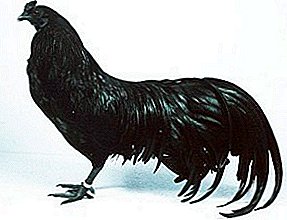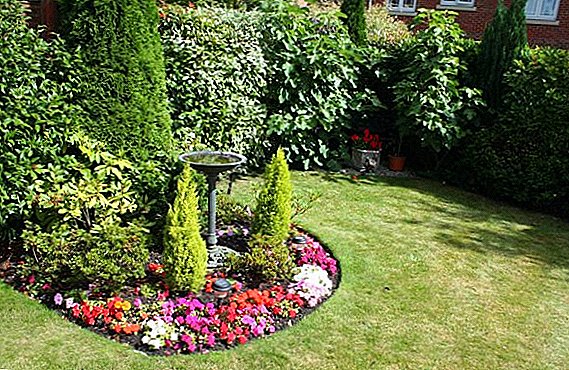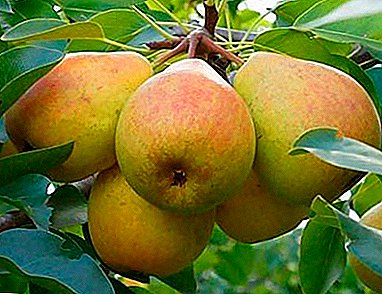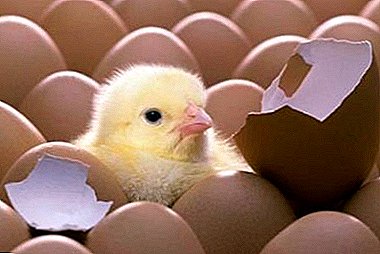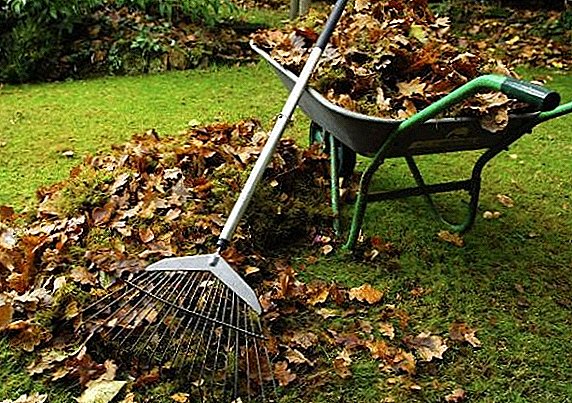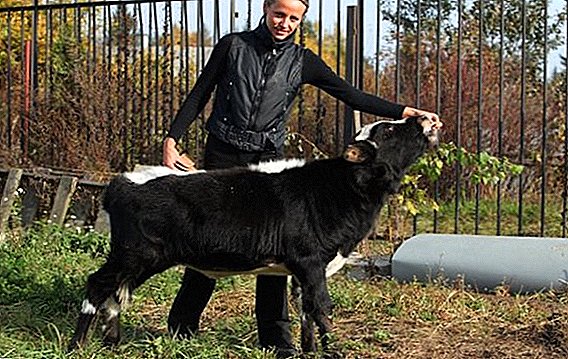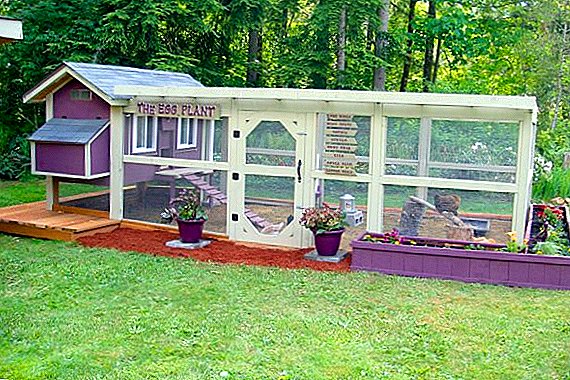 Many owners of private homes with a garden plots start a small farm for growing chickens. The main criterion of success is comfortable conditions, that is, maintenance, food and place of residence. On the construction of the summer version of the chicken coop for feathered pets with their own hands talk today.
Many owners of private homes with a garden plots start a small farm for growing chickens. The main criterion of success is comfortable conditions, that is, maintenance, food and place of residence. On the construction of the summer version of the chicken coop for feathered pets with their own hands talk today.
Basic requirements for the coop
Before being engaged in construction, beginners should learn about the conditions in which the productivity of the chicken will manifest itself to the maximum.
Important! Most breeds of birds do not tolerate noise: some experience noise hysteria, which affects egg production.
Location and Fence
The place for the room should not be located in the valley, because this is an accumulation of moisture, and moisture is an ideal environment for bacteria and fungi. The place should be slightly elevated, dry, sheltered from drafts. Nearby there should not be buildings with other living creatures that produce a lot of noise, roads with active traffic.  Chickens are mobile pets, their health and productivity depend on the quality and duration of walks. To make a yard for walking, it is enough to drive a few metal pipes and to cover them with a net from the sides. Part of a kind of aviary should be equipped with a canopy, where you can hide from rain or heat. The canopy will also provide protection from birds of prey.
Chickens are mobile pets, their health and productivity depend on the quality and duration of walks. To make a yard for walking, it is enough to drive a few metal pipes and to cover them with a net from the sides. Part of a kind of aviary should be equipped with a canopy, where you can hide from rain or heat. The canopy will also provide protection from birds of prey.
Poultry farmers should learn how to choose the right chicken coop, how to make a chicken coop with your own hands, how to build a chicken coop for the winter, and how to equip a chicken coop.
Microclimate
The productivity of the bird depends on the humidity and heat in the room. The temperature in the chicken coop is maintained in the range from 12 ° C to 24 ° C, the humidity is not higher than 75%. To maintain this mode, you need to think about the air ventilation system.
Ventilation will not only provide the necessary level of humidity - a well-thought-out system will remove the stale air and saturate the room with fresh, and in the heat to lower the temperature.  Ventilation in the hen house
Ventilation in the hen house
Arrangement
Each hen house contains:
- drinkers and feeders;
- soft flooring;
- baths for bathing in dust;
- perches and nests.
Lighting
In the hen house you need natural lighting in the form of windows, which will also serve as additional ventilation. Light in the life of a chicken plays a big role: for normal egg production, daylight hours should be 12-14 hours. Therefore, in the season of short daylight, electric lighting is especially important.
It will be useful for you to read about what kind of lighting should be in the chicken coop in winter.
It is best to conduct a system equipped with a timer to save and regulate the duration of the lighting. For every 3 square meters of area it is desirable to use a lamp with a heat of about 30 watts. 
DIY Coop
Based on the number of future pets, you first need a drawing and calculations of the amount of material, selection of tools and parts.
Did you know? Outrageous singer Lady Gaga is engaged in poultry farming, photos of her chicken coop along with her wards even appeared in her social networks.
Design
We think over the materials and parameters of the bird house:
- area - based on square meter per individual;
- the foundation is columnar, which will provide stability and some elevation;
- the main material is brick, wooden beam;
- the roof is gable, it will be better to keep warm;
- windows and doors - to the south side;
- separately you need to think of a small room for posterity;
- walking area - south facing;
- The height of the building is optimally 2.2 m.

Foundation device
Column foundation do the scheme:
- According to the size stated in the drawing, we install beacons from the posts and the tensioned rope.
- Around the perimeter we dig holes.
- A cushion of sand and gravel is placed on the bottom, bricks or small blocks with a hitch made of mortar are placed on top.
- The space left between the walls of the pit and the brick is covered with gravel.
- Make a harness from the bar for the floor.
Laying the floor
Having laid the logs under the flooring, the construction is covered with roofing felt to ensure waterproofing. Floorboards must be treated with antiseptic and moisture resistant drugs. Later, upon completion of construction, sawdust is poured on the floor with a thick layer. Many experienced farmers prefer this material because it is natural. 
Walling
Under the walls of wooden lumber set support at the stage of laying the floor, then gradually erect the frame, leaving openings for doors and windows.
If the walls are built of brick, their laying should be started before finishing flooring is carried out.
Important! Regardless of the material should be treated with antiseptic from the fungus.
Roofing device
Roof install on this technology:
- On the upper base of the walls set the rafters, upholstered waterproofing cloth. The strips of cloth are attached overlap.
- Under the outer roofing lay a sheathing of wooden planks, which will be attached to the outer material of the roof.
- It remains to hem the ceiling with plywood or other material.

Lighting
Conducting an electrician, it is important to consider such points:
- cables must be hidden so that the bird does not peck at them;
- selection of lamps equipped with shades;
- it is better to arrange the lamps so that the light does not fall on the nests;
- Systems with special connection blocks, with sockets and a timer are selected.
Ventilation
Ventilation should be considered at the design stage: there may be two versions of the system.
In order for the chicken to always be comfortable, it is necessary to properly equip the chicken coop. First and foremost, care should be taken about ventilation. Familiarize yourself with ventilation technology, which requires ventilation in the hen house, and learn about the types of ventilation.
The first is natural holes on opposite walls. On one wall, the holes are placed at a distance of 20 cm from the ceiling. On the opposite wall are the same, but at a distance of 20 cm from the floor. Both are equipped with a door-valve, which can adjust the intensity of the air flow.  The second ventilation option is arranged according to the same scheme, but there is an electric fan in the upper holes.
The second ventilation option is arranged according to the same scheme, but there is an electric fan in the upper holes.
Did you know? Chickens are amenable to training: in many circus programs you can see numbers with these birds, for example, in the Belarusian State Circus, in the Moscow Circus of Durov, in the National Circus of Ukraine.
Heat supply
Since the option of construction is summer, external insulation was not carried out, but it can be provided from the inside.
Natural insulation
For insulation take the following steps:
- install double glazing in the windows;
- do the platform;
- warm the ventilation pipes;
- use a gasket from the inside of the foam, foil screens.

Using electricity
As electric heating devices, convectors are most convenient. They are safe, economical, as they turn off when they reach the right temperature. In addition, such devices consume little energy.
Consider all the features of the content of chickens in the winter season and how to heat the chicken coop in winter.
Equally convenient are infrared heaters and lamps, which act in the same way. Their advantages are that they heat objects, which then give this heat to the surrounding space. Thus, the air in the room is not too dry, moreover, infrared radiation has a negative effect on bacteria. 
Without electricity
Gas boilers in a summer hen house are too troublesome because they require special maintenance. As for the furnace, its installation will require a chimney and fire protection for chickens: birds are extremely curious and can burn themselves - barriers will be needed. In addition, you need to take care of the wood.
How to equip the inside
When making a perch, it is advisable to make one tier so that the bird does not fight for the top one. The length of the pole corresponds to the width of the coop, the diameter of about five centimeters. The pole needs to be well sanded so that the chickens do not hurt their paws. The perches should not be above the nests, otherwise the eggs will be stained with feces. The number of perches is calculated on the desired number of hens, at least two poles.
Read about how to make a roost and a nest for laying hens with your own hands.
Depending on the breed of chickens for 3-5 birds you need one nest. Have them in unlit places. Dimensions approximately 30x40x40 cm, fill the nests with hay or sawdust.
As feeders, it is desirable to give preference to containers with a large-mesh mesh at the top. Wanting to eat, the bird will easily stick its head through the grid cell, but cannot scatter the food.  Feeders with a coarse mesh. Drinking bowls are also better to think over half-closed ones. Water in wide tanks can be dirty with droppings, sawdust, particles of fluff. Special drinkers will allow you to get water, while it will remain clean, and it will not have to change often.
Feeders with a coarse mesh. Drinking bowls are also better to think over half-closed ones. Water in wide tanks can be dirty with droppings, sawdust, particles of fluff. Special drinkers will allow you to get water, while it will remain clean, and it will not have to change often.
To get rid of moisture between feathers and possible parasites, feathery need ash baths. In the opposite side of the feeders, install a trough with sand and ash.
Keep clean
The most common problem arising from the operation of the chicken coop is the persistent smell of ammonia. To avoid this, do not treat floorboards with drugs from rot, in addition, it is worth changing the flooring as often as possible.
Every two months, they carry out a full cleaning of the premises, wash the walls, perch, floor, chicken dishes. It is important to monitor the purity of hay or sawdust in the nests. First, pass with a hard brush and clean warm water, then with detergent. In this case, you need to use only soft means, for example, a solution of apple cider vinegar with water (3: 2). In addition to disinfection, this composition also removes the smell.  Prevention against parasites and diseases is carried out with the help of iodine checkers, because they are safe: they are used without moving the bird. In big poultry houses use industrial preparations, such as "Bromosept", "Ecocide C".
Prevention against parasites and diseases is carried out with the help of iodine checkers, because they are safe: they are used without moving the bird. In big poultry houses use industrial preparations, such as "Bromosept", "Ecocide C".
To summarize: the summer version of the chicken house can serve even year-round, if you carefully plan your building. Convenient and careful filling of the bird's dwelling, its maintenance in cleanness will pay off a hundredfold with the productivity of feathered wards.





